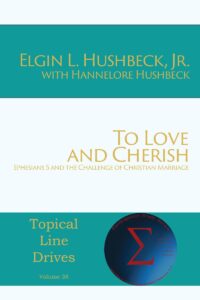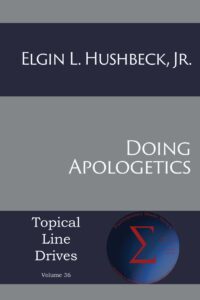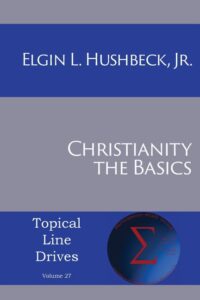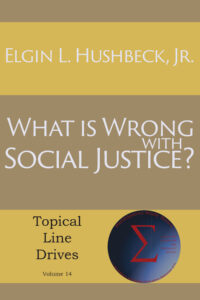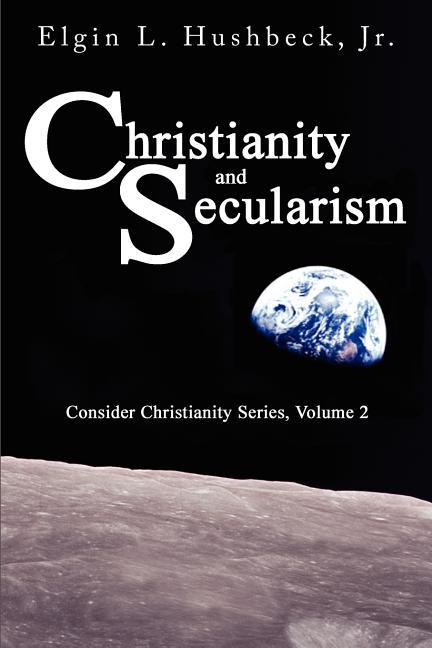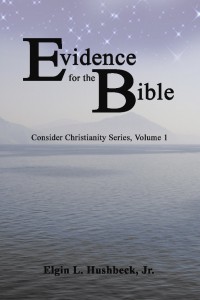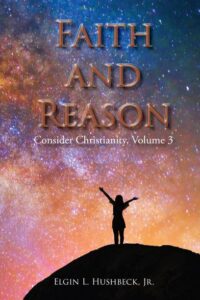The Epistles of John: Living in Truth and Love. 1 John 2:13-2:15
Saturday, February 18th, 2012 by Elgin HushbeckWeek 20: Feb 12, 2012
Last time we saw how John, after pointing out the inconsistency between the claims and the actions of his opponents, switched to talking about his readers, talking first about “children” i.e., about all Christians. Now he continues talking to “Father” i.e., church leaders, and then “Young men” which could be members in general, but might be deacons.
Study
d. Our Position (2:12-17)
i. Our position in Christ (2:12-14)
13a – I am writing to you, fathers,
because you have known the one who
has existed from the beginning.
– Clause 1.2
Fathers – πατέρες
– This was a common term that could be used to refer to
- General Ancestors (i.e., those who came before us) : Act 7:44 Our ancestors had the Tent of Testimony in the wilderness constructed
- Mentors or Spiritual Father: 1Cor 4:15 You may have 10,000 mentors who work for the Messiah, but not many fathers. For in the Messiah Jesus I became your father through the gospel.
- Natural Fathers : Heb 12:9 Furthermore, we had earthly fathers who disciplined us, and we respected them for it.
- Parents : Heb 11:23 By faith Moses was hidden by his parents for three months after he was born,
- Patriarchs : Rom 9:5 To the Israelis belong the patriarchs, and from them, the Messiah descended,
- Elders : Acts 7:2; 22:1 Stephen replied, “Listen, brothers and fathers!”
– Given the context here, I believe that the meaning of leaders is probably what John intended.
because you have known the one who has existed from the beginning.
– This passage ties back to verse 2:3 This is how we can be sure that we have come to know him. Like forgiven in the previous verse, known here is in the perfect tense, and refers to a completed action. Unlike verse 2:3, here John adds who has existed from the beginning. This is a statement of consistency and lack of change. A primary role of church leaders is to keep the members on track.
13b – I am writing to you, young people,
because you have overcome the evil one.
– Clause 1.3
Young people – νεανίσκοι
– Today it is easy to see this phase as referring to older children or perhaps teenagers. But the Bible does not really have these concepts, is has only children, adults and the elderly. In John’s day this term often referred to young adults between puberty and marriage, but could also be used to refer to a man in the prime of life. In the context here, it refers to those who are not “fathers.”
because you have overcome the evil one
– The Greek word translated overcome (νενικήκατε) means victorious, overcome, conquer. Like Forgiven and Known, it is in the perfect tense. This is something they already had done. The phase, the evil one (τὸν πονηρόν) is masculine singular, and thus points to a particular individual: Satan.
– As believers we already have overcome. Satan’s primary goal is to keep us from a saving relationship with Christ. By the very fact that we have entered into a saving relationship means that we have overcome Satan. Through the power of Christ we are victorious. Do we live as a victor?
14a – I have written to you, little children,
because you have known the Father.
– Clause 2.1
I have written – ἔγραψα
– As John begins the second half of the section he switches to aorist tense. For a discussion of the possible reasons for this, see the comments prior to verse 12 in last week’s post.
Little children – παιδία
– John also switches from τεκνία to παιδία. He elsewhere he uses the words interchangeably so change here is probably insignificant and just a stylistic change.
because you have known the Father.
– Again this is a completed action. In clause 1.1 John pointed out that their sins had been forgiven, here he reminds them that they have known the father. Together these two points encapsulates the teaching to this point. Those who confess their sins are forgiven and know God.
14b – I have written to you, fathers,
because you have known the one who
has existed from the beginning.
– Clause 2.2
– With the exception of the change from “I write” to “I have written” this is unchanged from Clause 1.2. As such it emphasizes the role of Fathers in providing consistency and lack of change.
14c – I have written to you, young people,
because you are strong
and because God’s word remains in you
and you have overcome the evil one.
– Clause 2.3
– This final clause repeats you have overcome the evil one found in the clause 1:3. But now precedes it with two additional descriptions. The first is that you are strong. We are strong in Christ and this is the reason we have overcome Satan. The second point is that God’s word remains in you. God’s word here could refer to several things. It could of course be a reference to the Bible. But it could also be a reference to Jesus as in John 1:1 In the beginning was the Word… Another option is that it could be a more general reference to the God speaking to us, not only through the Bible, but through prayer. This latter view is probably what John intended. But this could be a case of deliberate ambiguity, as none of these meanings is really wrong.
– That God’s word remains in us is the reason for our strength and our ability to overcome the evil one. It is the power of the message and truth of God and the relationship we have with him that gives us the strength to overcome. If we do not feel strong perhaps it is that we are not spending enough time with God’s Word or spending enough time with God in prayer.
Looking back over these six clauses, we can summarize the points that John uses to describe Christians as:
- We are forgiven. In the context of this letter this implies confession v 1:9.
- We know God. In the context of this letter this implies that we obey God v 2:3.
- We are strong.
- We remain in God’s word.
- We have overcome Satan.
ii. Warning: Do not love the world (2:15-17
15* – Don’t love[1] the world and the things that are in the world. If anyone persists in loving the world, the Father’s love is not in him.
– Having established his reader’s position in contrast to that of his opponents John now starts instructing them with a command.
Don’t love the world and the things that are in the world.
In context John has just set them apart from his opponents, so this is more of a warning (Don’t love), rather than a condemnation (Stop loving). But this warning immediately raises the question: What does John mean by “the world and the things that are in the world?” Some have taken this to mean that we should ignore the physical world and focus only on the spiritual. But there is a danger in this approach for it tends to lead to legalism, and in fact a lot of legalism has been grounded in verses such as this. After all, one simply needs to declare _______ to be “of the world” and they now have a “biblical” command against it!
A better approach would be to look at how John uses the term world (κόσμον). Here are some of the ways that John uses this term.
- 1:9-10 (In Darkness) He was the true light that enlightens every person by his coming into the world. He was in the world, and the world was made through him. Yet the world did not recognize him.
- 1:29 (in Sin) The next day John saw Jesus coming toward him and said, “Look, the Lamb of God who takes away the sin of the world!”
- 3:16 (Loved By God) “For this is how God loved the world: He gave his unique Son so that everyone who believes in him might not be lost but have eternal life.”
- 3:19 (This Realm) And this is the basis for judgment: The light has come into the world, but people loved the darkness more than the light because their actions were evil. — note difference between world and people (men)
- 7:7 (Evil and Hates Jesus) The world cannot hate you, but it hates me because I testify against it that its works are evil.
- 12:31 (ruled by Satan) Now is the time for the judgment of this world to begin. Now will the ruler of this world be thrown out.
- 14:17 (cannot receive the Holy Spirit) He is the Spirit of truth, whom the world cannot receive, because it neither sees him nor recognizes him. But you recognize him, because he lives with you and will be in you.
It is also important to remember that John, following Jesus’ example, normally speaks in spiritual terms, not material terms and as a result misunderstanding over this distinction plays a large role in the Gospel. As an example, consider John 2:19-20 Jesus answered them, “Destroy this sanctuary, and in three days I will rebuild it.” 20The Jews said, “This sanctuary has been under construction for 46 years, and you’re going to rebuild it in three days?”
Thus, the world in John is that part of reality that is in rebellion to God. It is in darkness and hates Jesus, and therefore cannot receive the Holy Spirit. It is ruled by Satan. Yet God loves the world and seeks to redeem the world, sending his son. He has redeemed us from the world, such that we are no longer a part of the world. Thus in John 15:19 If you belonged to the world, the world would love you as one of its own. But because you do not belong to the world and I have chosen you out of it, the world hates you.
If anyone persists in loving the world, the Father’s love is not in him.
– From the description above it is pretty clear that the love of God, and the love of the world are incompatible.
To fully understand this verse, it is important to consider what John says in verse 16. Unfortunately we ran out of time so this discussion will continue next week.
If you have question or comments about the class, feel free to send me an email at elgin@hushbeck.com and be sure to put “Epistles of John” in the header.
See here for references and more background on the class.
Scripture taken from the Holy Bible: International Standard Version®. Copyright © 1996-2008 by The ISV Foundation. ALL RIGHTS RESERVED INTERNATIONALLY. Used by permission. www.isv.org
Note: Some places I have modify the text from the ISV version. Passages that I have modified have been noted with and * by the verse number and the ISV text is included in a footnote.
Footnotes:
[1] 2:15 ISV Stop Loving..
